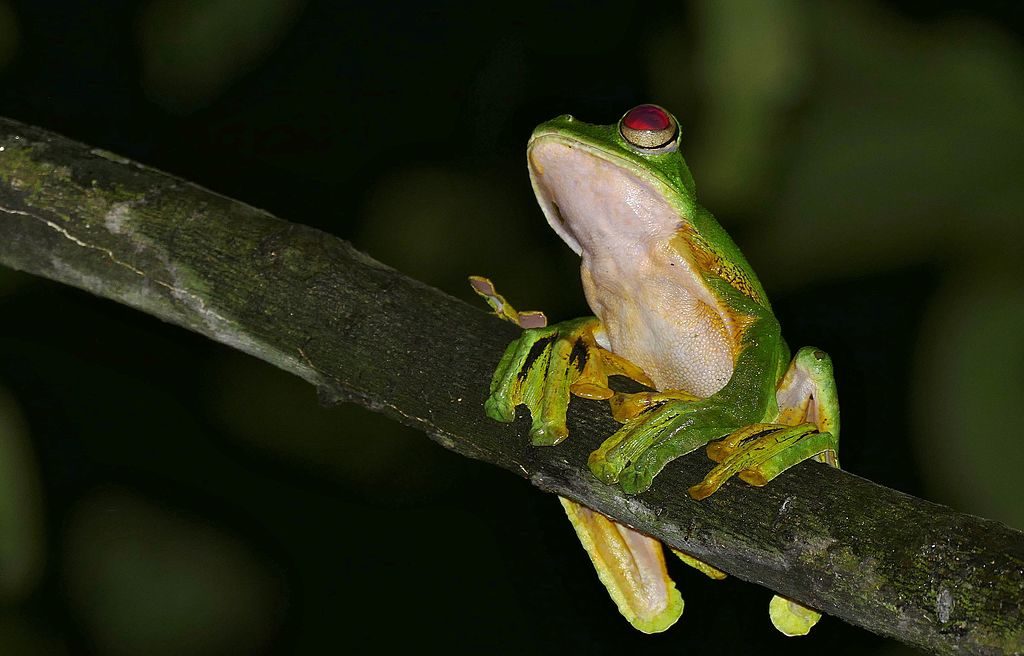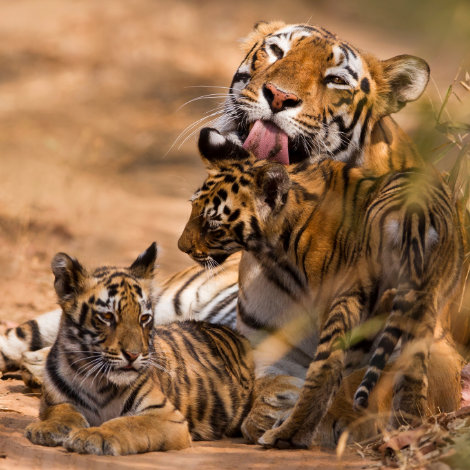Wallace's flying frog facts, pictures and in-depth information. Find out about an amazing flying frog that is capable of traveling up to 50ft. through the air!
Wallace's Flying Frog Facts At A Glance
- Other Name(s): Abah River flying frog
- Scientific name: Rhacophorus nigropalmatus
- Type of Animal: Amphibian
- Animal Family: Rhacophoridae
- Where Found: Peninsular Malaysia, Sumatra and Borneo
- Snout-Vent Length: Up to 9.0 cm (3.5 in), male; up to 10.0 cm (3.9 in), female
- Conservation Status: Least Concern
Watch the video below to find out more about the species, or scroll down for in-depth info on this awesome frog ...
Meet Wallace's Flying Frog: Introduction
Wallace's flying frog is a large tree frog found in rainforests in Southeast Asia. It is one of a number of ‘flying frogs’ that are able to glide from tree to tree with the aid of webbing between their fingers and toes.
Wallace's flying frog was one of the first flying frogs to be described (i.e. officially named as a species). The species is named after English naturalist Alfred Russel Wallace, who first discovered a specimen in Sarawak, Borneo.
Very little is known about this elusive species that spends most of its life high in the rainforest canopy.
What Does Wallace's Flying Frog Look Like?
Wallace's flying frog has flaps of skin along its sides. These increase the frog's total surface area when it glides. The limbs are long and slender, and the fingers and toes terminate in large, oval-shaped adhesive discs. These are thought to soften the frog’s landing, as well as to help the frog grip.
The frog’s back, head and outer limbs are vivid green, while the undersides are either white or pale yellow. The sides, fingers, toes and the inner surfaces of the thighs are bright yellow.
In addition to its larger size, Wallace's flying frog can be distinguished from similar species by the contrasting jet black color of the webbing between its digits. It may also have white blotches on its thighs and black spots on its flanks.
The frog's snout is blunt, and its large eyes are pale yellow with horizontal pupils. The prominent tympani (eardrums) are positioned behind the eyes and are roughly 1/2 or 2/3 of the diameter of the eye. The texture of the skin is fairly smooth on the upper side of the body and on the throat. The frog’s undersides are coarsely granulated.
Wallace's flying frog tadpoles are gray and have spotted tails. They grow to a total length of about 50 mm (2 in).
Distribution
Wallace's flying frog is found in Southeast Asia. There have been confirmed records of the species from the Malay Peninsula and from the islands of Borneo and Sumatra. It is likely that the distribution range is larger than existing records indicate and that the frog is also found in areas between the currently identified sites.
You can see this region on the map below:
Reports of frogs that could either be Wallace's flying frog or a very similar species have been made in several other countries including Laos, Vietnam and China.
Habitat
Wallace's flying frog occurs in moist tropical forests. The frog mainly occupies the mid-canopy level.
- You can find out about the different levels of a rainforest here: Rainforest Layers.
The species is mainly found in primary rainforests (i.e. in rainforests that have been untouched) but may also inhabit forests that have regrown after having been harvested. The frog is absent from all areas that lack tree or bush cover.
The species is arboreal (i.e. it lives exclusively in the trees), and comes down to the forest floor only to mate and to lay eggs in forest pools or animal wallows.
The species is typically found at elevations between 200 and 600 m (660 to 1960 ft.).
Gliding Flight
Watch the video below to see flying frogs in action:
Wallace's flying frog is one of several frog species that are capable of gliding flight. (Although the animal is known as a ‘flying frog’ it is not capable of true flight and can’t take off like a bird.)
Gliding flight involves descending at an angle less than 45 degrees relative to the horizontal (descending at a larger angle is known as parachuting).
Wallace's flying frog uses its gliding ability to search for food, escape predators, and to descend to the forest floor in order to mate.
How Far Can Wallace’s Flying Frog Glide?
When the frog leaps from a branch it extends its limbs and splays its webbed feet to create a large surface area. The membranes catch the air like sails, and allow the frog to glide distances of up to 15m (50 ft.).
The large suction pads at the tips of the frog's fingers and toes allow it to get a firm grip as soon as it lands. The frog can even cling on to vertical surfaces.
Breeding
Wallace's flying frog forms breeding aggregations (groups) on the ground near a body of water. The frogs gather in vegetation near to forest pools or by wallows – pools made by large mammals such as pigs and rhinos.
Female Wallace's flying frogs produce a fluid which they beat into foam with their hind limbs. They then lay their eggs inside the resulting bubble nest. The male frog fertilizes the eggs with sperm as they are being laid by the female.
The foamy egg mass is attached to branches, leaves or other suitable surfaces hanging over the water. When the embryos turn into larvae, the bubble nest falls apart, and the tadpoles drop into the water. The young stay in the pond or wallow until they have metamorphosed into the adult form.
- Want to know more about the life-cycle of amphibians? Check out this page: Amphibians: The Ultimate Guide.
What Do Wallace's Flying Frogs Eat?
Predators
Tree-climbing snakes are known predators of Wallace's flying frogs.
Is Wallace's Flying Frog Endangered?
Wallace's flying frog is rated 'Least Concern' by the IUCN.
The species is widely distributed and occurs in several protected areas. Its population is considered stable.
Notable declines only seem to affect frog populations in specific locations. These declines are usually caused by loss or degradation of the animal's forest habitat.
Wallace's flying frog is also captured for the pet trade but not in significant numbers.
Discover More Amazing Amphibians at Active Wild
- Become an amphibian expert! Visit this page: Amphibians: The Ultimate Guide
- The Mexican burrowing toad looks unlike any other frog: Mexican Burrowing Toad Facts
- The hellbender is the biggest amphibian found in the United States: Hellbender Facts
- The tiger salamander is a colorful North American salamander: Tiger Salamander Facts
- The goliath frog is the world's largest frog: Goliath Frog Facts
- The common mudpuppy is an amphibian that never grows up: Common Mudpuppy Facts
- The axolotl may be well-known, but it is critically endangered in the wild: Axolotl Facts
- Become an animal expert: Animals: The Ultimate Guide
- Discover amazing animals from all around the world: A to Z Animals




